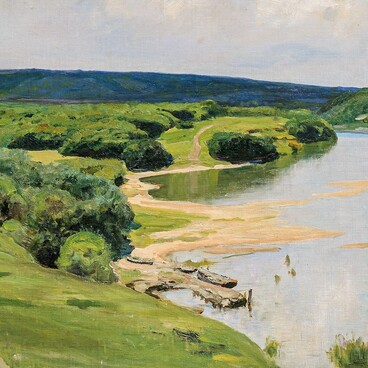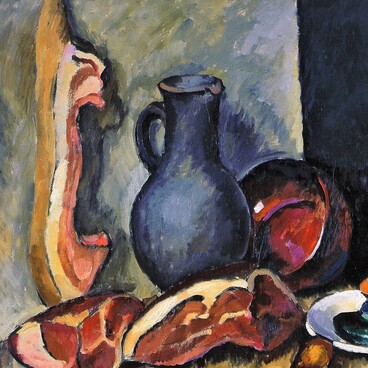Alexander Kuprin was born in 1880. He spent his childhood in Borisoglebsk and Voronezh, where his family moved in 1893. At the age of 16, Kuprin started working and attended evening classes at the Moscow Society of Art Lovers. After an unsuccessful attempt to enter the Imperial Academy of Arts, he attended the workshop of Lev Dmitriev-Kavkazsky in St. Petersburg, and later the studio of Konstantin Yuon in Moscow.
In 1906, Kuprin entered the Moscow School of Painting, Sculpture and Architecture. Soon, he developed an interest in the new French painting, which he saw in the collections of Russian patrons Sergei Shchukin and Savva Morozov. The artist also studied it during his trips around France and Northern Italy. He found like-minded people, who were fascinated with the French art, among the participants of the Jack of Diamonds group. The group’s aesthetic vision was strongly influenced by the paintings of Paul Cezanne and cubism, an art movement which breaks down objects into geometric shapes.
Kuprin was distinguished by an analytical approach in depicting objects in his still lifes. The artist preferred to depict artificial, unchanging objects, often used props. Fresh flowers appeared in his still lifes only in the 1930s.
Kuprin depicted not only the objects, but also the space surrounding them as solid matter. He sought to find and convey the inner structure of all objects. In comparison to classic still lifes, the artist chose unusual angles, so that the viewer could develop a different perspective with respect to everyday objects. To create the mood of a painting and a harmonious composition, he used contrasting and intense color combinations. These features of Kuprin’s artistic style were manifested in the ‘Still Life with scissors’, which is housed in the museum collection.
In later years, Kuprin moved away from the ‘Jack of Diamonds’ aesthetics and the avant-garde search for a new artistic language. His leading genre was landscape.
In 1906, Kuprin entered the Moscow School of Painting, Sculpture and Architecture. Soon, he developed an interest in the new French painting, which he saw in the collections of Russian patrons Sergei Shchukin and Savva Morozov. The artist also studied it during his trips around France and Northern Italy. He found like-minded people, who were fascinated with the French art, among the participants of the Jack of Diamonds group. The group’s aesthetic vision was strongly influenced by the paintings of Paul Cezanne and cubism, an art movement which breaks down objects into geometric shapes.
Kuprin was distinguished by an analytical approach in depicting objects in his still lifes. The artist preferred to depict artificial, unchanging objects, often used props. Fresh flowers appeared in his still lifes only in the 1930s.
Kuprin depicted not only the objects, but also the space surrounding them as solid matter. He sought to find and convey the inner structure of all objects. In comparison to classic still lifes, the artist chose unusual angles, so that the viewer could develop a different perspective with respect to everyday objects. To create the mood of a painting and a harmonious composition, he used contrasting and intense color combinations. These features of Kuprin’s artistic style were manifested in the ‘Still Life with scissors’, which is housed in the museum collection.
In later years, Kuprin moved away from the ‘Jack of Diamonds’ aesthetics and the avant-garde search for a new artistic language. His leading genre was landscape.



